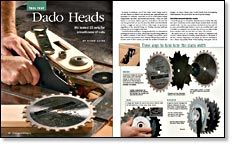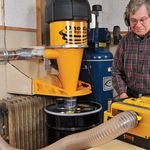
Synopsis: Steve Latta uses dado heads to cut tenons, dadoes, grooves, and rabbets in a variety of materials. Because the cost of a good set can run more than $200, most woodworkers have only one set, so it’s important to find one that works well and fits your budget. Latta tested 15 sets of 8-in stacked dado sets with carbide teeth. He and his students cut and compared more than 500 samples of dadoes cut cross-grain in red-oak veneer-core plywood and particleboard-core melamine. In addition to comparing dado brands, he also offers tips on using dado blades safely.
Brands tested include Amana 658030 and 658040, BC Saw & Tool 3008400, CMT Precision, Craftsman Excalibur 32608, Delta 35-535, DML Thoroughbred 73500 and 73504, Forrest Dado King, Freud SD608, Infinity Dadonator, Promax 07-80145, Ridge Carbide NW8-DM-DS, and Systimatic 37160.
In many woodshops, you’ll find dado heads being used to cut into sheets of veneer-core plywood and particleboard-core melamine for cabinetry casework, as well as solid lumber joinery (finger joints, lap joints, and mortise-and-tenons). I often use dado heads to cut tenons, dadoes, grooves, and rabbets. Because the cost of a good dado set can run more than $200, most woodworkers buy a single set and use it for a wide range of operations, regardless of the material being cut. Finding one that performs well and fits your budget is the trick.
I teach furniture making to young people who are interested in pursuing the trade as a career. When Fine Woodworking asked me to conduct a review of dado heads, I thought it would be a good idea to involve my students. Most of them will purchase a dado set at some point in their careers, and with the number of brands and designs out there, I knew they would benefit from investigating what separates the good from the not-so-good tooling.
Test setup ensured objective results
From the get-go we decided to limit the review to 8-in.-dia. (the size most commonly used in small shops) stacked dado sets with carbide teeth. You also can purchase stacked sets in 6-in. and 10- in. sizes and wobble-style dadoes. I never use a wobble dado, and I wouldn’t recommend one because the cut is not as clean as that from a stacked dado set and does not have a flat bottom.
We tested each set by cutting wide dadoes in melamine and red-oak veneer plywood (cutting perpendicular to the grain of the face veneer). Experience has taught me that it is essential to use a sharp, top-quality blade when making cross-grain cuts in plain-sliced red-oak veneer. The surface veneer on veneer-core plywood will always tear out more readily than lumber.
To prepare for the survey, we mounted a power feeder to a cabinet saw in the shop. A power feeder guaranteed that each sample was cut at the same feed rate and that it was held down under the same pressure. We also equipped the tablesaw with a new insert to minimize tearout on the outside edges of the dado cuts.
From Fine Woodworking #176
For the full article, download the PDF below:
Fine Woodworking Recommended Products

Veritas Precision Square

Ridgid EB4424 Oscillating Spindle/Belt Sander






















Log in or create an account to post a comment.
Sign up Log in